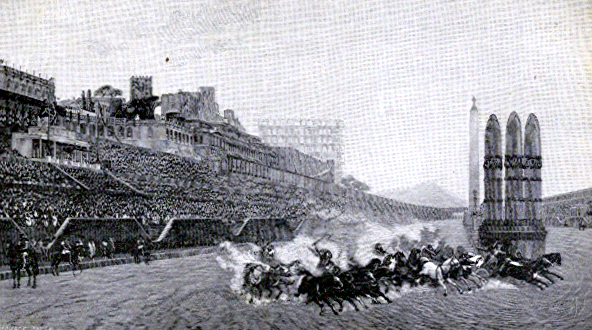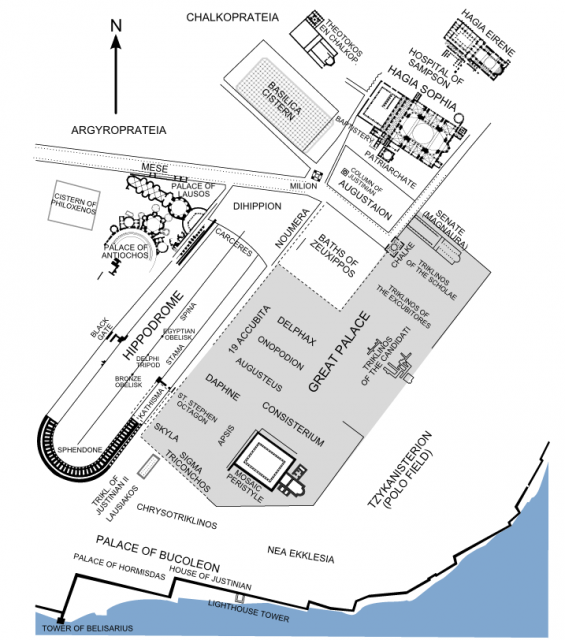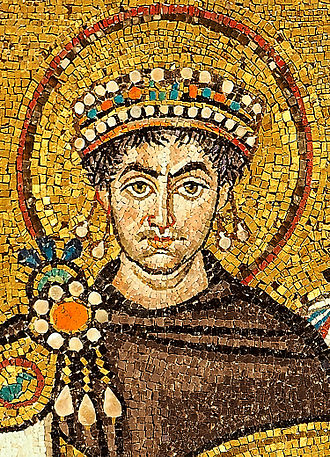Chariot racing had passionate and rowdy fans, and Constantinople was both the Capital of the Byzantine Empire and the capital of Chariot racing, having a Hippodrome (stadium) that could easily seat 80,000 spectators and had a private box from which the Emperor would often watch.
Chariot racing featured teams of four-horse chariots that raced around a simple oval track with long straightaways. Pileups were common and part of the thrill, as was cheering for your favorite team. Four teams initially were prevalent in races, but by this period only two teams known as the blues and the greens were popular, Justinian and his wife Theodora were noted blues fans.

Guards surrounded the church which was defended by a large angry mob, and a tense standoff ensued. The mob’s notion was that the men should be pardoned as they were saved by an act of God and thus received a holy pardon.
Justinian was too unsure to take any action and thought that the upcoming races would distract a lot of the protesters. His plan backfired terribly as the normally neutralizing fighting between the blues and greens halted as both team’s supporters banded together to hate the Emperor.
From his private box attached to the palace, Justinian heard death threats and proclamations of rebellion. All of the issues of the day were dredged up, from the costly wars too corrupt tax collectors and the unified hatred of 80,000 people soon turned to full-scale rioting.
Justinian and the royal party returned to the shelter of the palace complex and Justinian had plans to flee the capital for his own safety, fearing that a hostile takeover of the government was nearly unavoidable. The Rioters had begun to chant “Nika” meaning victory or conquer. it is unsure what was meant by this and it could range from declaring their own champions/victors, to calling for the conquering of Justian’s regime.
The rioters looted and set fire to many areas of the city, including the palace and the Hagia Sophia. To make matters worse, nearly all of Justinian’s detractors, including many senators who saw Justinian as an unfit ruler or despised his wife, Theodora, or simply wanted the throne to themselves, worked to fuel the riots.
Demands increased from the riot leaders and a leading, though unwilling, claimant to the throne, Hypatius, was quite literally dragged from his house to the Hippodrome and proclaimed emperor.
At first, Hypatius, a nephew to a former emperor, was reluctant to take the claim, fearing a lack of support. The scene of likely more than 80,000 now in the Hippodrome chanting his name seemed to change his mind and he went along with the proclamations while rampant violence was ongoing.
Justinian, still contemplating fleeing, had made moves to appease the rioters, mainly ousting many of the officials the rioter’s initially complained about, but appeasement did nothing for the angry mob, many of whom were now rioting simply to loot and create chaos as mob mentality took over.
The Nika Riots: Sports Riots that Nearly Toppled an Empire.
SHARES
| FacebookTwitter |

Theodora was an amazingly intelligent woman who rose to royalty from a lowly life essentially performing pornography and lewd comedy on stage. Her marriage to an Emperor was a major scandal, but Theodora completely reinvented herself after marriage to be the absolute best asset to her husband and the empire that she could be, essentially acting as an important advisor for Justinian throughout his reign.
Theodora’s words spurred Justinian into action and he formed a plan with his closest advisors. One advisor, Narses, was sent straight into the Hippodrome with plenty of treasury funds. He went straight to the leaders of the blues supporters and gave them the money and a message reminding them that they were rioting against Justinian, a loyal blues supporter.
The general Belisarius, at only 27, but fresh of campaigns against the Sassanid Empire, was chosen to lead an army against the rioters. Troops positioned themselves at every exit and proceeded to hack their way through the rioters turned revolutionaries.
As many as 30,000 revolutionaries were killed as there was simply no escape from the Hippodrome, and many other groups were easily dispersed once it was apparent that the army was out in force. Though it was a hard decision, Justinian had Hypatius killed as he simply had too much support to be spared.

Belisarius proved himself again in deftly leading the troops and was soon sent out on his famous campaigns to reconquer great swaths of old Western Roman Territory. Justinian and Theodora would rule for 33 more years. Justinian’s rule was so great that he would later go down in history as Saint Justinian the Great.
(note that the painting used for cover image is actually representing the Roman sack of Jerusalem, but gives a better understanding of the final stages of suppressing the riots.)
By William McLaughlin for War History Online

Δεν υπάρχουν σχόλια:
Δημοσίευση σχολίου